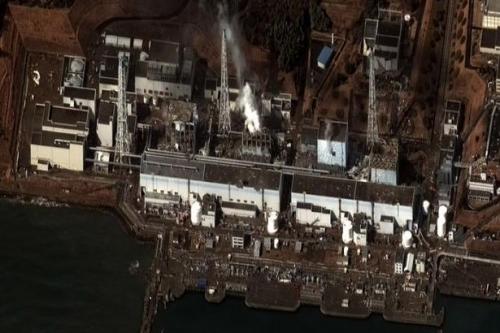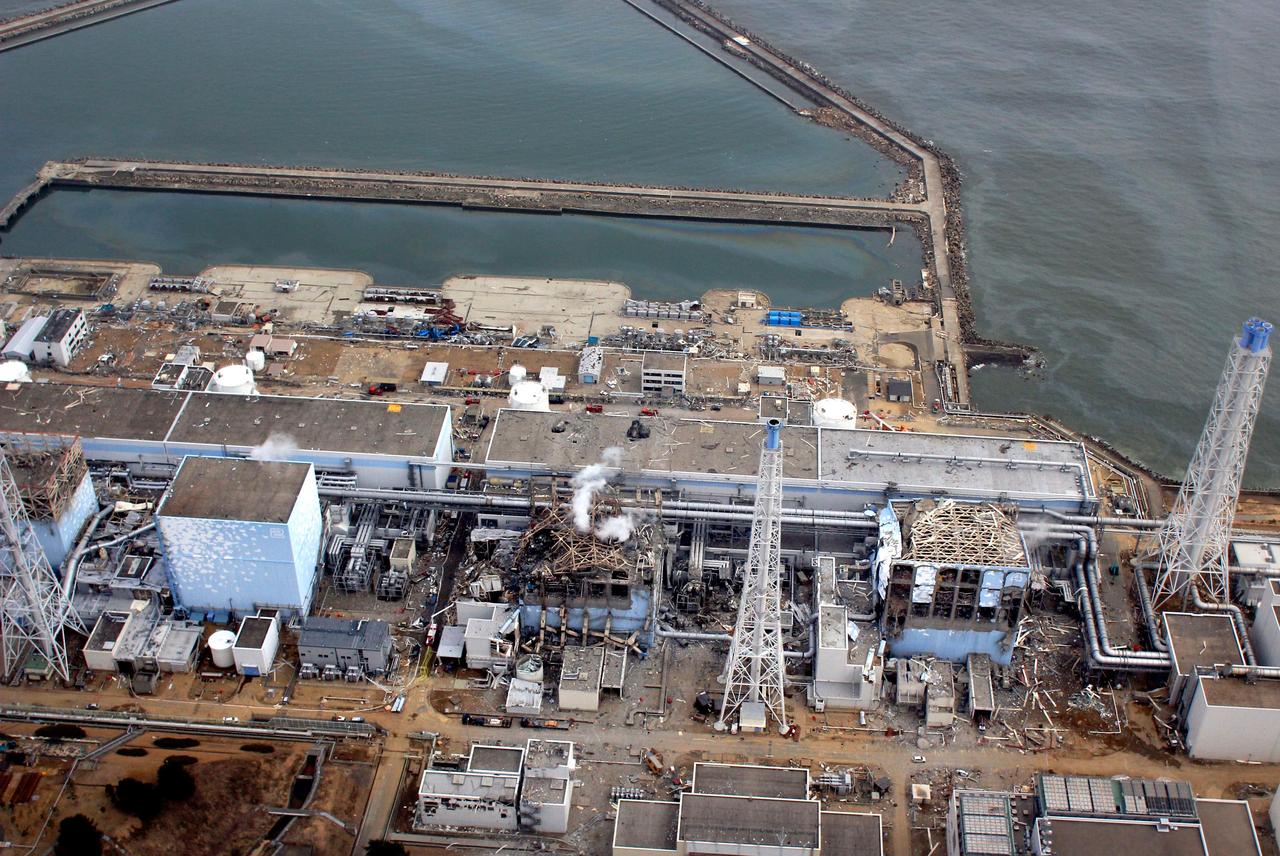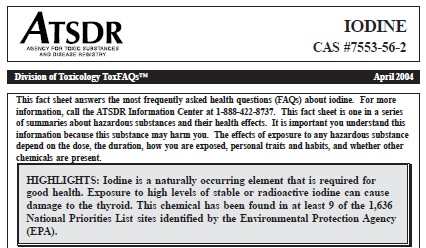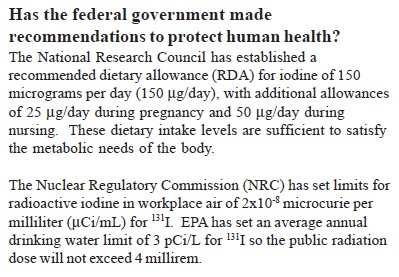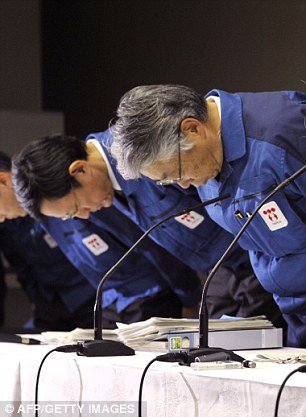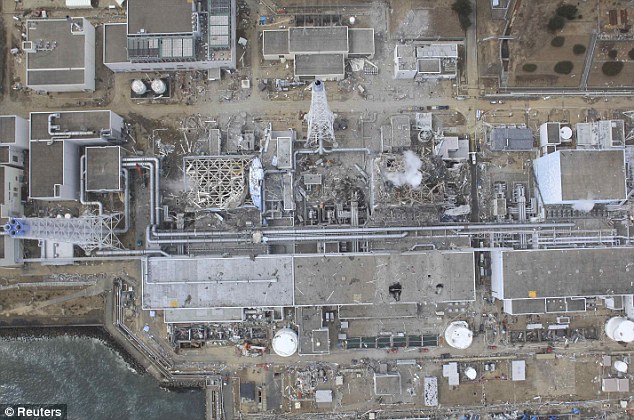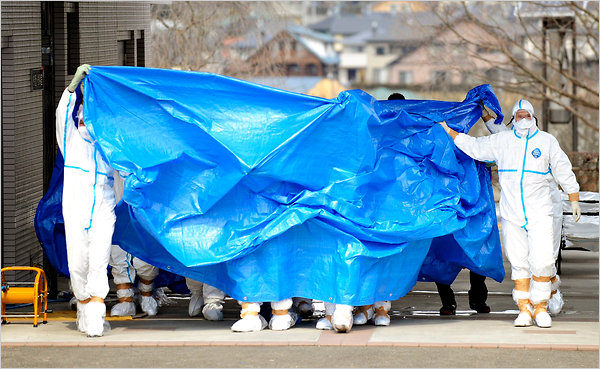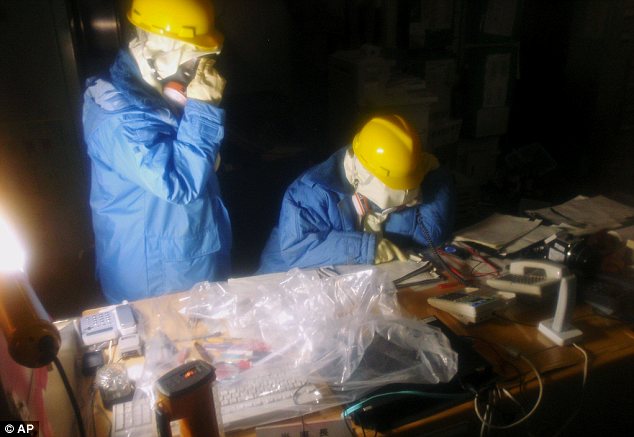– What They’re Covering Up at Fukushima:
Hirose Takashi: The Fukushima Nuclear Power Plant Accident and the State of the Media
Broadcast by Asahi NewStar, 17 March, 20:00
Interviewers: Yoh Sen’ei and Maeda Mari
Yo: Every day the local government is measuring the radioactivity. All the television stations are saying that while radiation is rising, it is still not high enough to be a danger to health. They compare it to a stomach x-ray, or if it goes up, to a CT scan. What is the truth of the matter?
Hirose: For example, yesterday. Around Fukushima Daiichi Station they measured 400 millisieverts – that’s per hour. With this measurement (Chief Cabinet Secretary) Edano admitted for the first time that there was a danger to health, but he didn’t explain what this means. All of the information media are at fault here I think. They are saying stupid things like, why, we are exposed to radiation all the time in our daily life, we get radiation from outer space. But that’s one millisievert per year. A year has 365 days, a day has 24 hours; multiply 365 by 24, you get 8760. Multiply the 400 millisieverts by that, you get 3,500,000 the normal dose. You call that safe? And what media have reported this? None. They compare it to a CT scan, which is over in an instant; that has nothing to do with it. The reason radioactivity can be measured is that radioactive material is escaping. What is dangerous is when that material enters your body and irradiates it from inside. These industry-mouthpiece scholars come on TV and what to they say? They say as you move away the radiation is reduced in inverse ratio to the square of the distance. I want to say the reverse. Internal irradiation happens when radioactive material is ingested into the body. What happens? Say there is a nuclear particle one meter away from you. You breathe it in, it sticks inside your body; the distance between you and it is now at the micron level. One meter is 1000 millimeters, one micron is one thousandth of a millimeter. That’s a thousand times a thousand squared. That’s the real meaning of “inverse ratio of the square of the distance.” Radiation exposure is increased by a factor of a trillion. Inhaling even the tiniest particle, that’s the danger.
Yo: So making comparisons with X-rays and CT scans has no meaning. Because you can breathe in radioactive material.
Hirose: That’s right. When it enters your body, there’s no telling where it will go. The biggest danger is women, especially pregnant women, and little children. Now they’re talking about iodine and cesium, but that’s only part of it, they’re not using the proper detection instruments. What they call monitoring means only measuring the amount of radiation in the air. Their instruments don’t eat. What they measure has no connection with the amount of radioactive material.
Hirose Takashi has written a whole shelf full of books, mostly on the nuclear power industry and the military-industrial complex. Probably his best known book is Nuclear Power Plants for Tokyo in which he took the logic of the nuke promoters to its logical conclusion: if you are so sure that they’re safe, why not build them in the center of the city, instead of hundreds of miles away where you lose half the electricity in the wires?
He did the TV interview that is partly translated below somewhat against his present impulses. I talked to him on the telephone today (March 22 , 2011) and he told me that while it made sense to oppose nuclear power back then, now that the disaster has begun he would just as soon remain silent, but the lies they are telling on the radio and TV are so gross that he cannot remain silent.
I have translated only about the first third of the interview (you can see the whole thing in Japanese on you-tube), the part that pertains particularly to what is happening at the Fukushima plants. In the latter part he talked about how dangerous radiation is in general, and also about the continuing danger of earthquakes.
After reading his account, you will wonder, why do they keep on sprinkling water on the reactors, rather than accept the sarcophagus solution [ie., entombing the reactors in concrete. Editors.] I think there are a couple of answers. One, those reactors were expensive, and they just can’t bear the idea of that huge a financial loss. But more importantly, accepting the sarcophagus solution means admitting that they were wrong, and that they couldn’t fix the things. On the one hand that’s too much guilt for a human being to bear. On the other, it means the defeat of the nuclear energy idea, an idea they hold to with almost religious devotion. And it means not just the loss of those six (or ten) reactors, it means shutting down all the others as well, a financial catastrophe. If they can only get them cooled down and running again they can say, See, nuclear power isn’t so dangerous after all. Fukushima is a drama with the whole world watching, that can end in the defeat or (in their frail, I think groundless, hope) victory for the nuclear industry. Hirose’s account can help us to understand what the drama is about.
– Douglas Lummis
See also:
– TEPCO: Fukushima Groundwater ‘Highly’ Radiation-Contaminated, Contains Radioactive Iodine 10,000 Times Legal Limit
– FOIA Request Shows EPA Prepares To Dramatically Increase Permissible Radioactive Releases In Drinking Water, Food And Soil After ‘Radiological Incidents’
– Dangerous Levels of Radioactive Cesuim 137 Found 25 Miles From Fukushima Plant
– TEPCO’s Totally Insane Disaster Plan At Fukushima Nuclear Plant
– TEPCO Chairman Admits Battle To Safe Fukushima Plant Lost, Reactors To Be Entombed
– US Government Admits Radiation Found In Milk from Washington State
– EU Erhöht Grenzwerte Drastisch! EU Raises ‘Safe Level’ of Cesium in Japanese Food By 20 Times!
– EU Drastically Raises Radiation Limits For Food! – EU Erhöht Drastisch Die Strahlungs-Grenzwerte Für Lebensmittel!
– Dr. Michio Kaku: Three Raging Nuclear Meltdowns In Progress!
– Greenpeace Radiology Experts Find High Levels Of Radiation Beyond No-Go Zone
– Japan Nuclear Meltdown Emergency: Fukushima Beyond Point Of No Return As Radioactive Core Melts Through Containment Vessel
– Japan Nuclear Meltdown: ‘Fukushima Plutonium Leak Comparable To Chernobyl Disaster’ (RT)
– Japan Nuclear Meltdown: Fatal Radiation Detected Outside Damaged Reactor No. 2
– Unbelievable: TEPCO: Plutonium Found On 5 Locations Around Fukushima Plant A Week Ago (But The Deadliest Substance On The Planet ‘Poses No Human Health Risk’!)
– Japanese Government: High Radiation Due To Partial Meltdown – TEPCO Admits Crisis May Last For ‘Months Or Years’
– US, Europe: Radiation and Jetstream FORECAST UPDATE (March 27, 2011)
– Updating Japan’s Nuclear Disaster
– Japan Nuclear Meltdown: Tests Find Radiation Levels At 100,000 Times Normal In No. 2 Reactor, Reactor May Be Leaking Water
– Japan’s Government Asks Water Treatment Plants Not To Take In Radioactive Rainwater
– Japan Nuclear Crisis: Engineers Toil To Pump Radioactive Nuclear Plant Water Into The Ocean
– Japan Nuclear Meltdown: Workers Try To Pump Out Radioactive Water From Reactors – Radiation Levels Soar To 10,000 Times Above Safety Limit
– Japan Nuclear Crisis: The Four Destroyed Reactors at Fukushima Was About 70 Billion Lethal Doses, finely divided
– Japan Nuclear Crisis: This Is Like Admitting That MOX Reactor No. 3 Has Been Breached And Has Released Plutonium
–Japan Nuclear Crisis: Close-Up Aerial Video of Wrecked Reactors at Fukushima (25.03.2011)
– Japan Nuclear Meltdown: High Levels of Radiation Leaking From Reactor No. 3
– Japan Nuclear Crisis: High-Radiation Leaks In Fukushima Reactors No. 1, No. 2 and No. 3
– Japan Nuclear Crisis: Fukushima Nuclear Plant Emitted A Neutron Beam 13 Separate Times
– Fukushima Engineer Says He Helped In Cover-Up: Fukushima Reactor No. 4 Built With Flawed Steel, Has A Faulty Reactor Inside
– Dr. Chris Busby: Fukushima Now 72,000 Times Hiroshima Radiation
– Japan Government on Fukushima: ‘We Are Not Able To Measure The Amount Of Radiation Coming From The Power Plant’
– The Dying ‘Fukushima Fifty’
– Japan Nuclear Meltdown: Reactor 3 ‘Nightmare’ – Reactor 1 ‘Worry’: Core Now At 380 Degrees Celsius, 80 More Than NORMAL Running Temperature
– Japan Officials Say HIGH SEAWATER RADIATION LEVELS Are NO Cause For Alarm
– Japan’s Science Ministry: Radiation Now Exceeds 400 Times Normal 40 km From Fukushima
– Japan Nuclear Crisis: Radioactive Iodine Content In Sea Water At 126.7 Times Limit, Caesium At 24.8 Times Limit
– Germany Keeps Radiation Measurements Secret Since Japan Nuclear Disaster
– WHO On Japan Food Radiation: ‘It’s A Lot More Serious Than Anybody Thought’
– Japan Nuclear Crisis: Emergency Evacuation Of Workers Ordered After Reactor No. 3 Emits Black Smoke
– Director General of Finland’s Nuclear Safety Authority Warns Japan About Using Seawater To Cool Fukushima Reactors
– Japan’s Health Ministry Tells Villagers Not To Drink Radioactive Tap Water
– Japan Nuclear Crisis: Fukushima Workers Cut Off From Their Families To Prevent The Truth From Leaking Out
– Japan Nuclear Meltdown: Mayor Urges Evacuation After Discovering Government Ignored, Misled Him And His People About True Dangers Of Nuclear Fallout
– Japan Nuclear Meltdown: Partially Accurate MSM Reporting Now Reduced To Lies And Propaganda
– Japan Nuclear Meltdown: Total Information Blackout On Fukushima Unit 4 Reactor
– Japan Nuclear Meltdown: It’s Getting Worse in Tokyo – Why The Dangers Are Stratospherically Higher Than Even US Officials Are Admitting
– Japan Finds Radioactive Food Up To 90 Miles From Fukushima Nuclear Site
– Japan Nuclear Meltdown: Multiple Times Worse than Chernobyl
– TEPCO Director Weeps After Finally Admitting The Truth About Fukushima Disaster: Radiation Leak Is Serious Enough To Kill People
– Fukushima Nuclear Power Plant In Japan: A Dirty Bomb Waiting To Go Off
– Japan Nuclear Meltdown: US Calls Radiation Levels ‘Extremely High’ – Fuel Pool Has Burned Dry At The No. 4 Reactor, Leaving Fuel Rods Stored There Exposed And Bleeding Radiation
– Japan Nuclear Meltdown: French minister: ‘Let’s not beat about the bush, they’ve essentially lost control’ – Radiation Levels Stop Military Helicopters From Dumping Water
– Japan Nuclear Meltdown: Radiation Levels 6,600 Times Normal 20km Away from Fukushima Nuclear Plant
– Japan Nuclear Meltdown: It’s Much, Much Worse Than It Looks (Thanks To The Stupidity of Nuclear Engineers!) (MUST-READ!)
– Israeli Nuclear Expert Accuses Japan Of Downplaying Danger Nuclear Calamity: ‘If there is fallout of plutonium oxide, a most toxic substance that they use in the reactor that exploded, no one will be able to set foot on the site for thousands of years’
